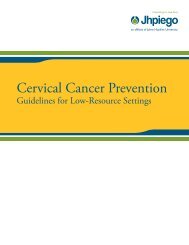Manual for Male Circumcision under Local Anaesthesia
Manual for Male Circumcision under Local Anaesthesia
Manual for Male Circumcision under Local Anaesthesia
You also want an ePaper? Increase the reach of your titles
YUMPU automatically turns print PDFs into web optimized ePapers that Google loves.
<strong>Male</strong> circumcision <strong>under</strong> local anaesthesia<br />
Version 3.1 (Dec09)<br />
COUNSELLING<br />
Basic facts about counselling b<br />
Counselling is a process in which individual<br />
communication is used to help people<br />
examine personal issues, make decisions,<br />
and make plans <strong>for</strong> taking action. In some<br />
types of counselling, the counsellor and<br />
client talk about whatever the client wishes.<br />
In counselling <strong>for</strong> male circumcision, the<br />
provider ensures that the client (or, if the<br />
client is a child, his parents) has all the<br />
in<strong>for</strong>mation he needs to make a decision<br />
about <strong>under</strong>going the procedure. HIV<br />
counselling concentrates on helping clients<br />
Counselling is not:<br />
• telling clients what<br />
to do;<br />
• criticizing clients;<br />
• <strong>for</strong>cing ideas or<br />
values on clients;<br />
• taking<br />
responsibility <strong>for</strong><br />
clients’ actions or<br />
decisions.<br />
reduce their risk of becoming infected with HIV – or <strong>for</strong> those already<br />
infected – transmitting the virus to others. In family planning<br />
counselling, the provider helps the clients make an in<strong>for</strong>med decision<br />
based on their reproductive intentions and personal situation.<br />
Counselling may involve some or all of the following:<br />
• Listening to clients (or parents, <strong>for</strong> circumcision in boys who are<br />
too young to <strong>under</strong>stand fully the reasons <strong>for</strong> circumcision and the<br />
risks associated with it, or who are below the legal age to consent<br />
to the operation).<br />
• Respecting clients’ needs, values, culture, religion, and lifestyle.<br />
• Talking with clients about the risks and benefits of the service<br />
requested, in this case male circumcision.<br />
• Answering questions about the male circumcision procedure and<br />
correcting any false in<strong>for</strong>mation.<br />
• Allowing clients and/or their parents to make their own in<strong>for</strong>med<br />
decision on whether or not to choose male circumcision.<br />
• Asking clients questions that help them identify behaviour that puts<br />
them at risk of STIs or HIV infection, or might do so after<br />
circumcision.<br />
• Helping clients <strong>under</strong>stand the benefits of knowing their HIV status.<br />
• Helping clients <strong>under</strong>stand their HIV or STI test results.<br />
• Helping HIV-negative clients <strong>under</strong>stand that male circumcision<br />
does not provide full protection against HIV infection, and<br />
suggesting how they can stay negative.<br />
• Helping HIV-positive clients find support and treatment services,<br />
and discussing ways to avoid transmitting HIV to others.<br />
• Helping clients obtain other services, such as family planning,<br />
screening and treatment <strong>for</strong> STIs, and counselling and treatment<br />
<strong>for</strong> alcohol and drug abuse.<br />
Confidentiality<br />
Confidentiality is an important characteristic of all sexual and<br />
reproductive health services. Counsellors should keep all client<br />
b<br />
Adapted from JHPIEGO’s Counseling and testing reference manual <strong>for</strong> lay counselors, 2002. [Full reference<br />
required]<br />
Educating and Counselling Clients and Obtaining In<strong>for</strong>med Consent Chapter 3-5
















